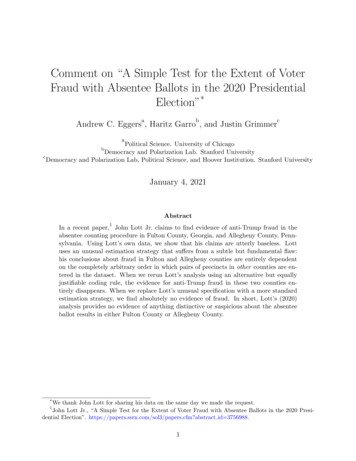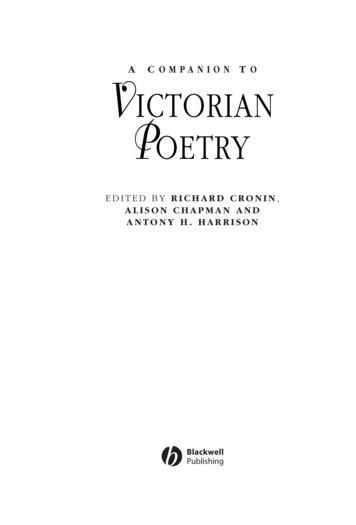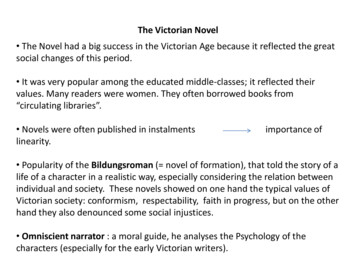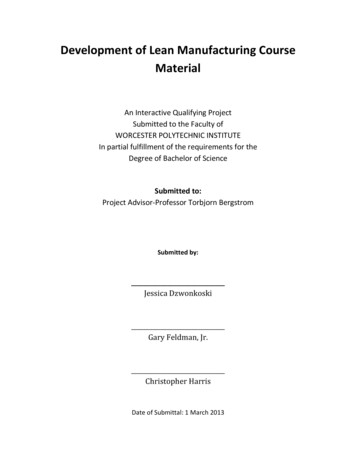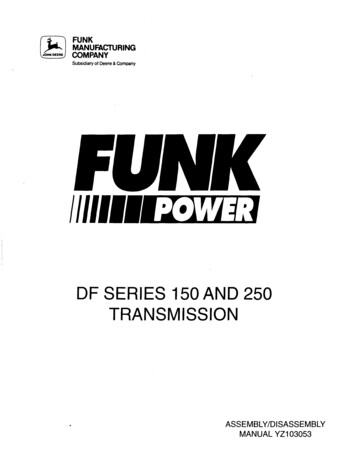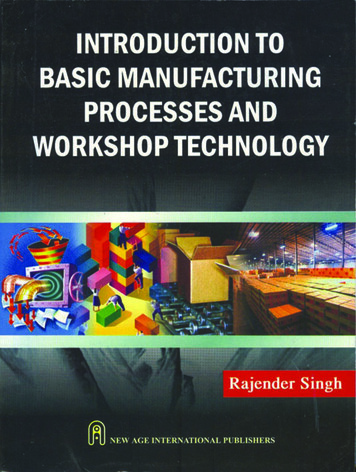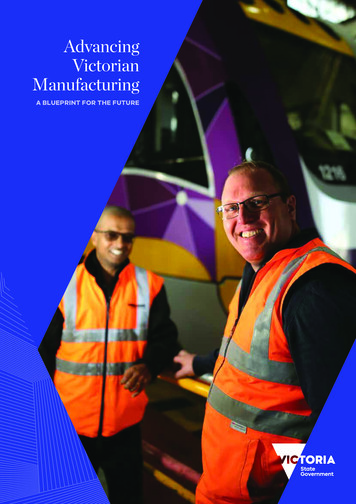
Transcription
AdvancingVictorianManufacturingA BLUEPRINT FOR THE FUTURE
Victoria’s AdvancedManufacturingAdvisory CouncilVictoria’s Advanced ManufacturingAdvisory Council is helping to shapethe future of Victoria’s advancedmanufacturing industry.Established in October 2016, the Council bringstogether leading experts from industry, unionsand academia to provide advice to the VictorianGovernment on priority areas and shape a positivefuture for Victorian manufacturing, including thedevelopment and implementation of this Statement.WHAT IS ADVANCEDMANUFACTURING?Advanced manufacturing describesbusinesses and supply chains thathave established sustainable globalcompetitiveness through advancedcapabilities and characteristics.These characteristics frequentlyfeature a combination of the following:The Council is chaired by highly respected industryexpert Mr Ross Pilling, who has more than 30 years’experience in the chemicals, manufacturing andservices industries across Australia, Malaysia,Singapore and the United Kingdom. Mr Pilling is aformer board member of the Australian Plastics andChemicals Industries Association and former DeputyNational President of the Australian Industry Group. anticipating market opportunitiesand customers’ needsThe Council is comprised of local, nationaland global leaders with a wealth of experience: being globally-oriented, integratedand connected Dr Angeline Achariya, Food InnovationCentre, Monash University utilising leading manufacturingtechnologies, techniques and data Mr George Argyrou, Hickory Group collaborating with business partners acrossvalue chains and with leading researchers. Mr Philip Binns, Agilent Technologies competing on value, including throughdeveloping and commercialisingproducts and processes with significantinternational competitive advantage having strong leadership, and investingin a highly-skilled workforce Ms Helen Chapman, BoeingAerostructures Australia Mr Steve Dargavel, AustralianManufacturing Workers' Union Mr Ben Davis, Australian Workers’ Union Dr Michelle McIntosh, Monash Instituteof Pharmaceutical Sciences Dr Fred Davis, Future Fibre Technologies Mr Alastair McLachlan, Preshafood Mr Jake Dingle, Carbon Revolution Ms Madeleine McManus OAM, Monash University Professor Bronwyn Fox, Factory of the Future,Swinburne University Dr Jane Oppenheim, Ego Pharmaceuticals Mr Phil Galloway, Syncline Energy Mr Tim Piper, Australian Industry Group Ms Lina Goodman, TIC Group Mr Brad Hordern, DuluxGroup Ms Dianne Smith, Melbourne Chamberof Commerce Ms Grace Lethlean, ANDHealth Mr Rohan Stocker, Marand Ms Ivy Leung, Hospira Ms Anna Reid, Asahi Beverages Mr Stuart Payne, GP Graders
Table of Contents2Premier’s Foreword3Minister’s Foreword4A New Vision for Victorian Manufacturing6Manufacturing is Central to Victoria’s economy8Building Victoria's Future Industries10Manufacturing in Metropolitan Melbourne11Manufacturing in Regional Victoria12Priority 1: Prepare for the Jobs of the Future16 Priority 2: Innovate to Capture High-Value Manufacturing Opportunities20 Priority 3: Build Scale, Capability and Supply Chain Excellence24 Priority 4: Foster a Globally Competitive Business Environment30 Advancing Victorian Manufacturing Together31Helping Victorian Businesses Connect Globally1
Premier’s ForewordI’ve heard people say Victorian manufacturingis disappearing. It’s simply not true.Victorian manufacturing is a 26 billion industryemploying more than 283,000 men and women –making it one of the state's largest suppliersof full-time jobs.Of course, Victorian manufacturing is going througha transition – moving away from being a sectordominated by automotive manufacturing towardsa more diverse mix of industries ranging from foodto aviation, biotech to construction.The point is this: Victorian manufacturingis not disappearing, but it is changing.And we must ensure those changes benefitthe Victorian economy and Victorian workers.We cannot do it alone. We need the continued inputof business, industry and research – and critically,we need support from the Commonwealth.Because our Government will never stop fightingfor Victorian manufacturing and Victorian jobs.To win that fight and find a path forward forVictorian manufacturing, we must capitaliseon our current success, as well as addressingexisting challenges.ADVANCING VICTORIAN MANUFACTURINGAnd we must make sure the hard-working menand women who laid the foundations of our proudmanufacturing history are not left behind.Advanced manufacturing is key to this transition.It will be a catalyst for the development of theknowledge economy – stimulating research anddevelopment and the commercialisation of newideas and technologies – and it has the potentialto create the kinds of high-skilled, sustainable,full-time jobs we need to secure our future prosperity.Manufacturing is not a niche industry. It is a diverseand dynamic sector that creates real jobs for abroad range of men and women across our state.It is the industry that connects the doers anddreamers and thinkers of our economy. It is ourfuture, and we need to make it work.Hon. Daniel Andrews MPPremier of Victoria
Minister’s ForewordVictoria is one of the world’s mostdiverse, dynamic communities.That diversity and dynamism is one of thesecret ingredients of our growth and prosperity– especially in our manufacturing industry.One of the great privileges of my job is that I getto meet people and companies who literally makeour economy work. People like Anne Koopmann –a methods engineer with Bombardier Transportationin Dandenong who moved to Australia five years agoand is now Victoria’s reigning Young Manufacturerof the Year. And organisations like Deakin Universityin Geelong, who recently signed a 58 million dealto licence its cutting edge technology to LeMondComposites for everything from bicycle toautomotive manufacturing.Victoria has the talent and culture to becomea hub for advanced manufacturing.Philip Leslie – the technical lead at GlaxoSmithKlinein Boronia – made an interesting comment whenhe was inducted into the Victorian ManufacturingHall of Fame this year. “The culture of Australia isa pioneering culture,” Philip said, “and that appliesto me and what we can do here.”Philip is right. The challenge ahead of us is to backup that pioneering spirit with a drive for excellence– attracting and training the best talent, continuallystriving for innovation and improvement, andidentifying and removing barriers to productivity.Advancing Victorian manufacturing mattersfor three reasons. It is a catalyst for technology,innovation and research across a broad rangeof industries – factors that are fundamental tothe development of a knowledge economy.It creates the kind of sustainable jobs that weneed to remain one of the world’s most liveableplaces. And it connects us to the opportunitiesthat will be created during the Asian Century– as industrialisation and urbanisation acrossAsia create an unprecedented market forquality goods and services.That’s why this Statement, Advancing VictorianManufacturing, is so important.This Statement is a blueprint for the ongoingdevelopment of advanced manufacturing inmetropolitan and regional Victoria. It maps thecurrent size and shape of the industry, outlinesthe vision for the industry, then details the actionsthat need to be taken to realise that vision.I would like to thank the businesses, industryassociations, unions and research organisationswho contributed their time, expertise and ideasduring the preparation of this Statement. I wouldalso like to particularly acknowledge the ongoingwork of the Victorian Government’s AdvancedManufacturing Advisory Council in shaping ourvision for advanced manufacturing.I look forward to working with Victoria’s diverseand dynamic manufacturing industry to realisethe vision set out in this Statement.This Statement is all about making a betterfuture for the men and women of Victoria.Hon. Wade Noonan MPMinister for Industry and Employment23
A New Vision forVictorian ManufacturingOUR VISIONDESIGNING, CREATING AND MANUFACTURINGIN VICTORIA FOR THE WORLD.Victoria will be home to internationally competitive manufacturerscreating value from design, engineering, data and services to groweconomic opportunity and jobs for Victorians.This Statement sets out actions in four domains to realise this vision.1 repare for thePjobs of the future2Innovate to capturehigh-value manufacturingopportunitiesThe Government will:The Government will: Target specific skills needs through thework of the Victorian Skills Commissionerand support the development of needsdriven training packages designed for thenext generation of manufacturing jobs. Strengthen links between industry andresearch, design and engineering capabilitiesand facilitate uptake of transformativetechnologies to create new high-valueproducts, processes and market opportunities. Promote and link opportunities for science,technology, engineering and mathematics(STEM) graduates and other high-skillprofessionals within manufacturing inpartnership with education providersand industry organisations. Facilitate improved access to risk capitalfor scale-up and start-up advancedmanufacturing businesses. Support industry associations to delivermanufacturing leaders forums and othermechanisms to enhance managementand leadership capabilities.ADVANCING VICTORIAN MANUFACTURING Further strengthen procurement processesto better support innovative design,engineering and manufacturing. Secure Victoria’s global position as aleader in engineered materials suchas fibre composites.
Innovate toCapture , quite rightly, aspireto a prosperous, caring, inclusiveand cohesive society. A balancedand healthy economy is critical torealising this aspiration, and wecannot have sustainable economicsuccess without a vibrant andsuccessful manufacturing industry.”Preparefor theJobs of theFutureDESIGNING,CREATING ANDMANUFACTURINGIN VICTORIAFOR THE WORLDFoster a GloballyCompetitiveBusinessEnvironmentBuild Scale,Capability, and SupplyChain ExcellenceRoss Pilling, Chair of the AdvancedManufacturing Advisory Council3Build scale, capabilityand supply chainexcellence4Foster aglobally competitivebusiness environmentThe Government will:The Government will: Help small and medium enterprises (SMEs)enhance their business capabilities to capturemore market and supply chain opportunities. Boost Victorian manufacturers' capabilitiesto export and secure global supplychain opportunities. Drive the digital transformation ofmanufacturing through training,demonstrations and knowledge exchangeto share global best practices andoptimised processes across Victoria’smanufacturing industry. Prioritise attraction of advanced manufacturinginvestment in Victoria as part of the state’sinvestment attraction strategy. Work with industry to create place-basedeconomic development plans, facilitatingthe future development of high-performingand cooperative clusters. Work with the Commonwealth Governmentto enhance the benefit of its expenditurefor Victorian manufacturers, and advocatefor competitive national tax andregulatory settings. Work with industry to manage exposureto volatility in energy markets.45
Manufacturing is centralto Victoria’s economyManufacturing is a cornerstone of theVictorian economy, providing a diverserange of jobs, high-quality exports andsubstantial economic growth.and world-leading education, research anddevelopment (R&D) capabilities. As a consequence,our manufacturing industry can deliver real andsignificant immediate and long-term economic gains.Manufacturing is Victoria’s third largestemployer, employing over 283,000 Victorians.In 2016, manufacturing employment growth wasthe fastest of any industry category in Victoria,with around 40,000 new jobs created.Manufacturing is a catalyst for growth, innovationand prosperity, creating significant demandfrom key sectors – such as mining, agricultureand wholesale trade – and jobs in a wide rangeof supporting industries, including accounting,logistics, personnel management, legal and ITservices and marketing.The Victorian Government recognisesmanufacturing’s strategic importance, and iscommitted to supporting the industry’s growth.Around the world, the nature of manufacturingis changing. It has become increasinglyinterdependent with services, design and digitaltechnologies. Today, manufacturing is characterisedby complex connections across global value chains,with final products often an amalgam of expertise,parts and services from around the world.A growing proportion of the value generatedby manufacturing stems from pre- and postproduction activities such as R&D, design,engineering, supply chain management, logisticsand after-sale services. In fact, it’s estimated athird of the total value of manufactured productsin developed countries can be accounted forby services inputs – making manufacturingan important driver of the service sector.Victoria is well-positioned to take advantageof these global manufacturing trends. The state hasa highly skilled workforce, connected supply chains,exceptional design and engineering expertise,Now more than ever, a strong, internationallycompetitive manufacturing industry is needed toensure a balanced economy, sustainable growthand a prosperous Victoria.MANUFACTURING IN VICTORIAVICTORIAEXPORTEDMANUFACTURINGIS VICTORIA'S3RD LARGEST EMPLOYER 17.88bOVER80%OF MANUFACTURING JOBSOF MANUFACTUREDGOODS IN 2015/16ADVANCING VICTORIAN MANUFACTURING283,000 JOBSARE FULL-TIME
VICTORIA’S STRENGTHS Highly skilled workforce trained in global best practices S trong digital technology capabilities and the largest number ofhighly qualified ICT graduates in Australia E xpertise in design and engineering relevant to leading edge manufactured productsand processes, with the largest number of qualified engineering graduates in Australia Highly developed professional services sector G lobal hub for science infrastructure and technology, and world leadingR&D in high growth sectors High-quality supporting infrastructure and clusters of excellence W ell-developed freight and logistics systems, including Australia's largest container portand a 24-hour international airport Renewable energy targets provide manufacturers certainty and opportunity Accessible to Asia Pacific with similar time zones Melbourne has been awarded the world's most liveable city seven years in a row Competitive business costs Enabling regulatory regimeMANUFACTURINGINDUSTRYCONTRIBUTED 25.9b7.5MANUFACTURING IS#1PRIVATE NEWCAPITAL SPENDING 564m 678m%OFVICTORIA’SGVA**GROSS VALUE ADDED IN 2015/16INDUSTRY FORR&D SPENDINGIN VICTORIAINCREASED BY 20%BETWEENMARCH2016AND*GROSSVALUEADDEDIN 2015/16VICTORIA LEADS THE NATIONMARCH 2017 IN VICTORIANMANUFACTURING*2013-14 LATEST DATA AVAILABLE*FOUR-QUARTER AVERAGE67
Building Victoria's Future IndustriesThe Victorian Government’s Future Industries initiative is focused on securing Victoria’s economicprosperity. It is supporting the transition of Victoria’s economy now and establishing the buildingblocks for future growth. The Future Industries with core manufacturing capabilities are:CONSTRUCTIONTECHNOLOGIESSector StrategyCONSTRUCTION TECHNOLOGIES Victoria’s construction industry grew by more than 2 billion from 2015 to 2016,contributing 23.9 billion to the state’s economy. Significant Victorian Government infrastructure spend and private developmentis leading to high employment growth with 25,000 more jobs from 2015 to 2016.Victoria’sFutureIndustries.9611 DEDJTR IT VFI Construction Technology Strategy FA.indd 18/03/2016 4:23 PMDEFENCETECHNOLOGIESSector StrategyDEFENCE TECHNOLOGIES The defence sector contributes up to 8 billion annually to the state's economy.Victoria’sFutureIndustries. The sector includes more than 400 businesses and employs around 20,000 people(including Australian Defence Organisation employees), manufacturing leading-edgeproducts for local and global supply chains.FOOD AND FIBRESector StrategyFOOD AND FIBRE Victoria's biggest export sector, including 38 per cent growth in exports of prepared foodsfrom 2014-15 to 2015-16.MEDICALTECHNOLOGIES ANDVictoria’sPHARMACEUTICALS Steady jobs growth in food product AL TECHNOLOGIES AND PHARMACEUTICALS 69 per cent growth in exports of pharmaceutical products from 2015 to 2016. Steady employment growth in pharmaceuticals manufacturing.Victoria’sFutureIndustries.NEW ENERGYTECHNOLOGIESSector StrategyNEW ENERGY TECHNOLOGIES Victoria is creating opportunities for manufacturers and other businesses to improveenergy efficiency and productivity.Victoria’sFutureIndustries. Victoria’s Renewable Energy Targets will support up to 2.5 billion of direct investmentin Victoria, and create up to 11,000 jobs.TRANSPORTTECHNOLOGIESSector StrategyTRANSPORT TECHNOLOGIES Competitive design and engineering capabilities supporting the manufacture of trains,trams, buses, caravans, trucks, marine and aerospace technology, and intelligenttransport systems.Victoria’sFutureIndustries. The Victorian Rolling Stock Strategy: Trains, Trams, Jobs 2015-2025 details theVictorian Government's 10 year investment of more than 3.6 billion in a pipeline oflocal train and tram building and maintenance, supporting thousands of local jobs.Sector strategies can be viewed at: business.vic.gov.au/futureindustriesADVANCING VICTORIAN MANUFACTURING
NEW ENERGY TECHNOLOGIES: DRIVING MANUFACTURING GROWTHThe Victorian Government is creating businessopportunities and jobs throughout the newenergy technologies sector and supply chain.These opportunities span renewable energy,energy efficiency, and innovative productsand services that increase consumers’ controlover the energy they use, and help to ensurean affordable, reliable and renewable energysupply. Importantly for business, the broaderadoption of new energy technologies can assistwith energy costs. This has been supported bythe most significant government investment inrenewable energy in Victoria’s history with the 146 million Renewable Energy Action Plan.The Victorian Renewable Energy Targets of25 per cent by 2020 and 40 per cent by 2025and the associated auction scheme will drivenew projects in Victoria, increasing capitalinvestment and creating jobs.This pipeline of projects will help businessesestablish and build their manufacturingpresence in Victoria, as seen with KeppelPrince Engineering's recent expansion of itsPortland wind tower manufacturing business.The Victorian Government’s 20 millionNew Energy Jobs Fund is supporting advancedmanufacturing, including: SEA Electric is establishing an electric vehiclemanufacturing facility in Victoria to producean innovative range of electric-poweredcommercial vehicles. Moreland City Council is establishingAustralia's first commercial-scale hydrogenrefuelling station, which will help transitionthe council's diesel-fuelled waste trucks tohydrogen. As part of the project, the councilis working with H2U and a global vehiclemanufacturer to develop and test newprototype vehicles. Energy software developer Geli Australia isworking locally to develop their home energymonitoring and control systems for Victorians.New ways of accessing and working with dataare also creating business opportunities andjobs in Victoria. Businesses such as Greensync(a Victorian energy data and microgrids company),Geli (a Silicon Valley leader in software controls),and Tilt Renewables (a renewable energy companythat has shifted its headquarters to Victoria)are already capitalising on the advantages ofchoosing to locate their operations in Victoria’sinnovative environment.Through our New Energy Technologies SectorStrategy, we are working to ensure Victoria isrecognised globally as a thriving business hubfor the development and manufacturing of newenergy technology products and ies89
Manufacturing inMetropolitan MelbourneGreater Melbourne is the powerhouse ofAustralian manufacturing. Local and globalcompanies choose to locate and headquarterin Melbourne to manufacture a large rangeof finished products and intermediary goodsfor global supply chains.WESTCompanies specialising in themanufacture of prefabricatedconstruction materials, buildingfittings and furniture, processedfoods, beverages, packagingmaterials, chemicals, paperproducts, specialty vehicles,paints and coatings, textiles,steel fabricated products andheavy engineering.NORTHCompanies specialising in the manufacture of steelproducts, aluminium, packaging, industrial tools,specialised machines, construction materials, food andbeverages, paint, chemicals and plastics, caravans,automotive components and pharmaceuticals.MELBOURNE'S NORTHMELBOURNE'S WESTMELBOURNE'S EASTINNER METROMELBOURNE'S SOUTHINNERSOUTH EASTINNER METRO ANDINNER SOUTH EASTCentral Melbourne is home toglobal headquarters, designand engineering companies,research and developmentand advanced manufacturersacross all sectors.EAST AND SOUTHMelbourne’s East and South is home to largemanufacturers of transport equipment,automotive and transport components,plastics and chemicals, medical devices,pharmaceuticals and food and fibre.MELBOURNE – CONNECTING EXCELLENCEMelbourne has the economic strengths that makemanufacturing a success, including a growingpopulation, great lifestyle, skilled workforce, renownededucation system and world-class infrastructure.Combined with the lowest office leasing and industrialland prices on the eastern seaboard, Australia’slargest container port and a 24-hour internationalairport, these factors make Melbourne a great placeto do business.Plan Melbourne 2017-2050 sets out the VictorianGovernment’s vision for Melbourne’s growth andcomplements industry, infrastructure, educationand skills strategies important to economic growth.Plan Melbourne 2017-2050 is focused on integratinglong-term land use, infrastructure and transportplanning to meet future environmental, population,housing and employment needs. This includesidentification of significant national industrialprecincts and employment and innovation clustersthat will be a focus for jobs and investment growth.ADVANCING VICTORIAN MANUFACTURINGSupporting Plan Melbourne 2017-2050, the recentlyestablished Suburban Development portfolio willcoordinate Metropolitan Partnerships, bringingtogether local government, industry and communityto advise on initiatives that will attract investment,create jobs and improve liveability. SuburbanDevelopment will also produce five year Jobs, Servicesand Infrastructure Plans that will provide a regionallevel analysis of Victorian Government investmentsand initiatives designed to strengthen liveability andsupport jobs growth.Poised to take advantage of current momentum andgrowth opportunities, manufacturers are supportedby the Victorian Government through a dedicatednetwork of offices and specialist staff across greaterMelbourne with business matching, site selection andtargeted grants and vic.gov.auwww.tradeandinvestment.vic.gov.au
Manufacturing inRegional VictoriaMALLEE AND LODDON CAMPASPECompanies specialising in the manufacture of food, off-roadvehicles for defence, steel castings, pumps, vacuum trucks anddrain cleaning technology, specialist engineered equipment,fibreglass tanks, machinery and industrial equipment.Regional Victoria has aproud manufacturing historyand is home to more than20 per cent of Victoria'smanufacturing businesses.The manufacturing industrymakes a huge contribution inregional Victoria, contributing 8 billion or 12 per cent ofregional economic activity.GOULBURN ANDOVENS MURRAYCompanies specialising inthe manufacture of food,fibre, electricity transformers,substations and powersupply products, andproducts for defence.MALLEEWIMMERASOUTHERN MALLEELODDONCAMPASPEOVENSMURRAYGOULBURNGRAMPIANS ANDCENTRAL HIGHLANDSCompanies specialising inthe manufacture of food, rail,road and agriculture transportequipment, mining equipment,textiles, paint, and a clusterof component manufacturerswho work mainly with thetransport and defence sectors.CENTRALHIGHLANDSGIPPSLANDGREATSOUTH COASTBARWONBARWON AND GREAT SOUTH COASTCompanies specialising in the manufactureof food, construction materials, chemicalsand plastics, oil refining, aluminium smelting,carbon fibre products and industrialstructures such as wind towers and bridges.GIPPSLANDCompanies specialising inthe manufacture of food,fibre, construction materials,light aircraft and materialshandling equipment.THE MANUFACTURING STATEManufacturing in regional Victoria offers anabundance of opportunities to invest and do business,offering low costs, affordable industrial land, accessto high-quality raw materials and resources, andstrategic road and rail links to Melbourne, Sydney,Brisbane and Adelaide, supported by a strong freighttransport and logistics capability. All centred aroundVictoria’s vibrant regional cities, offering close-knitcommunities and collaborative business networks.The 500 million Regional Jobs and InfrastructureFund is the Government’s flagship program forboosting jobs and investment in regional Victoria.It invests in growing jobs, building infrastructureand strengthening communities in regional Victoria.In 2016, the Victorian Government establishednine Regional Partnerships, giving communitiesthe opportunity to provide a direct voice intogovernment decision-making, including initiativesto support industry development.Already, the Victorian Government is investing 45 million to boost digital connectivity for regionalcommunities, including better broadband inindustrial and business precincts.Other steps to support companies and boostregional jobs growth include reducing the payrolltax rate by 25 per cent for all businesses operatingmostly in regional Victoria, making it the lowest taxrate in the country.Regional manufacturers are supported by the VictorianGovernment through a dedicated network of officesand specialist staff across regional Victoria providingbusiness matching, site selection and targeted grantsand www.tradeandinvestment.vic.gov.au1011
PRIORITY 1Prepare for theJobs of the FutureAmongst Victoria’s most important assets isour highly skilled workforce, and world-classeducation system. The further growth ofmanufacturing will draw on this strength asthe skills mix required to support advancedprocesses continues to evolve. Supportingworkers to upskill with industry advancements,and promoting manufacturing as a futurecareer option are part of the actions beingtaken by the Victorian Government toposition the industry for the next phaseof manufacturing innovation.“Our skills base can become a realpoint of competitive advantage forVictoria. Staff who have advancedproblem solving skills are goingto be in clear demand acrossmanufacturing businesses. We havean outstanding platform to build onas the Education State – enhancingthe great skills we already have inthe workforce, along with programsfor those just joining.”Anna Reid, Advanced Manufacturing AdvisoryCouncil member, and Regional ManufacturingOperations Manager – Asahi BeveragesADVANCING VICTORIAN MANUFACTURINGWHAT THE VICTORIAN GOVERNMENTIS CURRENTLY DOINGReal Training for Real JobsThe Government is taking action to address skillsshortages in key specialist occupations, and ensuringthe next generation of manufacturing workersreceive the training they need for the next generationof manufacturing jobs.The Government is: Reforming Victoria’s training system via Skills First,backed up with funding of an extra 114 million in2017 for the TAFE sector, acknowledging its distinctrole as a public provider. This funding boost is ontop of the TAFE Rescue Fund ( 320 million over fouryears) and the 50 million TAFE Back to Work Fund. Implementing the 34 million Regional Skills Fund,to support strategic projects and retain a skilledworkforce in regional areas; and the Regional andSpecialist Training Fund (an initial allocation of 30 million in 2017), to respond to industry demandfor local training and skills requirements. Establishing the Major Projects Skills Guarantee,which ensures that at least 10 per cent of all workon major projects in Victoria is done by trainees,apprentices and cadets. Since commencing on1 January 2016, the Guarantee has generatedmore than 1,500 employment opportunitiesfor Victorians.
The Government is also reforming the training systemto better align training and qualification pathwayswith the needs of Victoria’s manufacturing industry.The Victorian Skills Commissioner has created a newsystem for industry to engage on skills issues, makingour state more responsive to the evolving needs ofadvanced manufacturers.This reform is supported by the Workforce TrainingInnovation Fund, which provides an initial allocationof 40 million in 2017 to promote innovative trainingand skills in emerging and priority industries.Supporting Existing Workers Investing 128 million in the Tech Schools Initiativeto construct and establish 10 Tech Schools focusedon giving the next generation of Victorians the nextgeneration of skills. Rolling out the Primary Maths and ScienceSpecialists program to make sure primary schoolteachers have the skills they need in STEM; andfunding the John Monash Science School, Victoria’sfirst specialist secondary school focusing on STEM. Implementing Victoria’s International EducationSector Strategy, which includes attracting morestudents to regional centres.A top priority is ensuring that high-quality upskillingand retraining opportunities are available to existingmanufacturing workers. Supporting technology skills through initiativessuch as Launchpad, SummerTech Live, and digitalliteracy and engagement pilot programs.The Government is:Management and Leadership Providin
I've heard people say Victorian manufacturing is disappearing. It's simply not true. Victorian manufacturing is a 26 billion industry employing more than 283,000 men and women - making it one of the state's largest suppliers of full-time jobs. Of course, Victorian manufacturing is going through a transition - moving away from being a .
